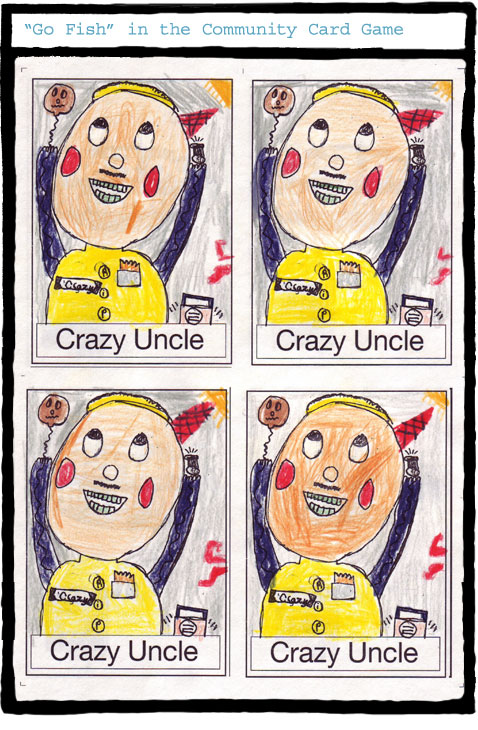Work by the Grade 4
Art Class at FACTS, 2008–09.
Click a thumbnail to see it full size.
Download the Lesson Plan for “Go Fish” in the Community Card Game.
Here are some things to think about:
Who is in your own gallery of valued cultural treasures?
From who have you learned? (And what?)
What do you value and want to pass on?
Where have you taken a stand?
Playing & Learning With Folk Arts

“Go Fish” in the Community Card Game
Background
Third-grade students began by assessing or surveying their communities. They were asked to name and identify features (types of people) and members (roles, jobs, activities) present within their extended communities. They were asked: “Who are community members?”
This included a discussion of types vs. individuals. Students were asked to name people— not as individuals (Uncle Bob) but in terms of categories and types of location – job, role, where you see them, what are they doing when you see them. There are people you see everyday. What is regular vs. incidental occurrence.
Grouped into teams, each student was given a web – a circle with many other circles leading into the middle. They were given definitions of community members: people we see around us in places we live. With that list in mind, they brainstormed. Some in different neighborhoods and different communities might name different categories or types. Discussion included exploration of roles: some positive, some negative. Not just all the good guys are named. Not just the bullies.
Based on these lists and webs, there was further verbal exploration: How do you visually describe someone? This was followed by discussion of what it means to illustrate something: how do you convey ideas through your drawing, using clothing, tools, equipment and location to help position / describe a community member visually.
Making Go Fish cards
Kids pick one character they want to focus on, and develop a sketched image.
Kids do master drawings, and the teacher produces a template, with four copies of each illustration— a way to create the cards that will be used for the Go Fish game.
Kids added color to their own images / sets of four. Kids exchange cards, keeping 1-2 they created and exchanging with others to create their own deck of 12 sets of characters (4 of each).
Go Fish card game
Then, teach the card game Go fish. There is a full session of playing with rules. (“Do you have a Kid in a Tree?” “Do you have a Crying Baby? Crazy Uncle? Noisy neighbors?”)
Students take the cards home, and the following week, the teacher asks: “How many people played the game with someone in the family or in the neighborhood? Did you have to teach the rules, explain community?
Finally, the teacher gives them a simple template they can use to decorate and create a case for the cards.













